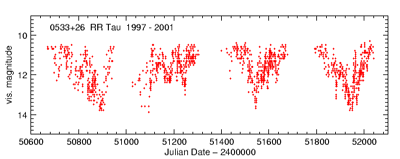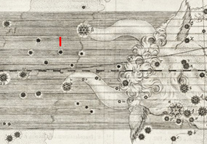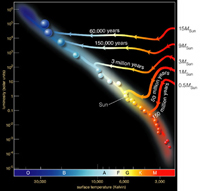"Stars are equal; it is not birth but mass that makes the difference"
- (paraphrasing Voltaire on men)
Birth of a star: getting to the main sequence
Young stellar objects show a multitude of different phenomena that are related to the formation and early evolution of stars. The life of a star begins with gravitational contraction in a dense interstellar cloud. Initiated by some external perturbation, like a nearby supernova explosion, seeds of stars are created via increased density in molecular clouds, which eventually lead to an accelerated contraction of matter. Star formation is also accompanied by complex inflow and outflow processes that will determine the final mass of the newly formed star.
During the contraction phase, the central regions of these protostars are heated up, first by converting gravitational potential energy to heat and then by igniting the first thermonuclear reactions in form of nuclear burning of deuterium. When the protostar reaches a certain temperature, external mass accretion stops due to the increased radiation pressure. After this point, the star will continue its contraction until the core temperature reaches about 107 K and hydrogen fusion is ignited. Ordinary stars will spend most of their lifetimes converting hydrogen to helium in their cores and it is this phase of energy production that defines the main sequence of the Hertzsprung-Russell diagram.
Young stellar objects between the end of external mass accretion and beginning of core hydrogen burning are called pre-main sequence (PMS) stars. As always in stellar astrophysics, different classes of PMS objects have been defined according to their masses. Low-mass objects with masses around 1 solar mass are known as T Tauri stars, whose formation is reasonably well-understood (see also T Tauri in the VSOTS Archive). Massive stars with masses greater than 10 solar masses are only formed in giant molecular clouds and these objects spend their whole PMS time as obscured objects, optically invisible due to extremely strong dust obscuration. Intermediate-mass PMS stars between about 2 and 10 solar masses, are in many sense the interface between low-mass and high-mass star formation, thus bridging the gap between the two ends of the mass spectrum. Named after George H. Herbig, who first studied them in a systematic way (Herbig 1960), these objects are the Herbig Ae/Be (HAEBE) stars. RR Tau, the Winter 2007 Variable Star of the Season, is one of the best studied northern HAEBE stars with spectacular light variations.
HAEBE or not HAEBE?
 |
| George H. Herbig, Astronomer Emeritus of the University of Hawaii |
The HAEBE stars were first discussed as a group in a paper by Herbig (1960) that started a whole new research field. He studied Ae and Be stars (i.e. stars of spectral types A and B, showing emission lines in their spectra) associated with a nebulosity, and selected a sample of 26 stars based on three criteria:
- The star has spectral type A or B with emission lines,
- it is located in an obscured region, and
- the star illuminates a bright nebulosity in its immediate vicinity.
As Herbig (1960) pointed out in the abstract of his paper, "the peculiarities did not appear unique to this group: they may be found as well in stars that are not associated with nebulosity." Indeed, more recent discoveries of objects that share many but not all of the properties in Herbig's list justifies a slight adjustment of the definition. In particular, many new HAEBE stars have been revealed that appear isolated, i.e. they are not associated with nebulosity and are not clearly located in an area of active star formation. Waters & Waelkens (1998), in their review paper, summarized the latest developments in the following modified working definition of HAEBE stars: (a) spectral type A or B with emission lines, (b) infrared excess radiation due to hot or cool circumstellar dust or both, and (c) luminosity class III to V.
In recent years, HAEBE stars have gained considerable interest as the possible progenitors of beta Pictoris and Vega-type stars, which are intermediate-mass main-sequence objects surrounded by circumstellar debris disks. Various arguments that the existence of these disks points to the presence of planetary bodies open the possibility that the environment of HAEBE stars is the site of current planet formation (Waters & Waelkens 1998).
RR Tau, as one of the 26 stars on the list of Herbig (1960), shares all points of the initial group definition. Its location in a small dark cloud was noticed by Hoffmeister (1949); the bright nebulosity was discovered by George Herbig himself in the early 1950's. The brightest feature of this nebulosity is a knot about 14" east of the variable star; from this knot and from the star two faint arcs run to about 50" northward of RR Tau.
These structures are clearly visible in the Digitized Sky Survey images shown above. Further faint structures are extended towards the northwest, where long filaments go well beyond the boundaries of the image.
The bright knot in the nebulosity, which is, in principle, a relatively easy target for CCD observers, was found to change in brightess by Herbig (1960), thus its physical association to RR Tau is clearly established. Recently, the Hubble Space Telescope captured the details of this knot at an unprecedented level, revealing tiny filaments apparently pointing away from the star. It is not yet clear what kind of interactions take place between RR Tau and its immediate vicinity.
The variable star RR Tau: further acronyms on the way
Probably the most exciting feature of RR Tau (at least for AAVSO observers) is its violent variability in the optical spectral region. The full range of variation extends over 3 magnitudes with maxima at 10.6 mag and minima down to 13.8-14.0 mag. Moreover, the variations occur on timescales as short as a day and are completely unpredictable! To illustrate the point, we show the AAVSO light curve for four consecutive seasons between 1997 and 2001. The apparent "scatter" of the curve is actually quite misleading: it is the rapid day-to-day variability that makes the light curve seemingly thick.
 |
| The visual light curve of RR Tau based on observations collected by the AAVSO. Besides the seasonal gaps in the data, the plot clearly illustrates the unpredictable variability of this star. |
A number of studies addressed photometric, polarimetric, and spectroscopic variations of RR Tau (see the references below). The emerging picture is the following. There are well-defined trends between brightness, color, and polarization during the strong fadings that dominate the light curve. As the star fades, it becomes redder, but in the deepest minima the B-V color reverses, becoming bluer for V>13.0 mag. Photopolarimetry showed sharp increases in the percentage of linearly polarized light during photometric minima, with stronger polarization seen at shorter wavelengths. These characteristics (large, aperiodic optical minima, reddening followed by a bluening at deepest minima, and anticorrelated polarization) place RR Tau in the UXOR subclass of HAEBE stars, named after the prototype UX Orionis.
Roughly one in every four HAEBEs belong to the UXOR group. Although they were identified in the late 1960's (referred to as "Algol-type minima" stars), the physical mechanism of variability is still rather controversial. The leading model assumes that the minima are caused by obscuration of the star by large orbiting circumstellar clouds (Grinin 1988). This theory explains well the bluening effect and increased polarization in minima, both a result of increased percentage of scattered starlight by dust during optical minima. However, the model would require a nearly edge-on disk configuration if clouds are orbiting in a Keplerian disk, which is not supported by independent estimates of disk inclination angle. Another theory suggests that the obscuring bodies are infalling "cometary" bodies, similar to the model developed for the young main-sequence star beta Pictoris ("clumpy" accretion by Graham 1992). However, to reproduce the observed deep fadings, very large dust comae (comparable to the size of the star) or a very large number of them are required. A variation of the model assumes instabilities in the circumstellar disk leading to variable obscuration (Bertout 2000).
A fundamentally different model attributes the source of the photometric variability to a variable accretion flow onto the star (Herbst & Shevchenko 1999). In this model the dominant source of the optical brightness is accretion luminosity. At maximum light we see the optically thick surface of the accretion disk, while at optical minima, the external accretion diminishes to the point that the disk becomes transparent and we can see the underlying star. So this is in stark contrast with the obscuration hypothesis: instead of assuming that the brightest state represents the true luminosity of the star, the accretion model implies that only at optical minima can we see the star itself. In this respect, this model resembles the one that has been widely accepted for the FU Orionis-type outbursts of young stars (known as FUORs, see also FU Ori)
A recent spectroscopic study of RR Tau, which also made use of the simultaneous AAVSO light curve (Rodgers et al. 2002), found supporting evidence for the obscuration models, in which a featureless absorber moves in and out of the line of sight, thus causing fadings and rebrightenings. The obscuring screen acts as "nature's coronograph", blocking the source of the continuum radiation and some portion of the circumstellar environment. Interestingly, the majority of the low-density wind exists outside of the obscured region. Rodgers et al. (2002) concluded that the obscuration was caused by a dusty absorber bigger than the star itself but still smaller than the circumstellar envelope. However, apart from the general picture, not much is known about the origin and fate of these dusty clouds, so that further investigations should be performed before concluding that we understand all important problems about RR Tau and its siblings.
Observing RR Tauri
 |
| The constellation Taurus from Johann Bayer's Uranometria (1603). 125 Tau, the starting point of the star hop to RR Tau, is shown by the red mark roughly half-way between the endpoints of the bullhorns (β and ζ Tauri). (Credit: Linda Hall Library) |
RR Tau is a perfect observing target for every clear night with a moderate-sized telescope that can go close to the inner sanctum ranges (magnitude 13.8 or fainter) - that means a 6-to-10-inch telescope depending on your light pollution. Since the variations are seemingly irregular and completely unpredictable, it is worth following as often as possible. Charts of C- and D-scale contain 125 Tau, which is a 5.2 mag star easily identifiable in as early publications as Johann Bayer's Uranometria from 1603. Observers with CCD cameras may want to record the image of the reflection nebula around RR Tau and its variations in time. Good seeing for this is essential because the brightest knot of the nebula is only a few arcseconds across.
RR Tau can be seen in a good portion of the year to northern observers with winter as the best observing season. Due to its proximity to the ecliptic plane, the star is unobservable between mid-May and early August. For the same reason there can be monthly gaps when the Moon is hanging around. Every other clear night could, however, bring surprising turns in the brightness of the star, so that everyone interested can start following RR Tau and its unexpected fadings. Observations may then be submitted to the AAVSO, where they will be added to the 90-year database for the star (the first observations go back to early 1917). For those interested in this very interesting variable star, we wish clear skies throughout the observing season - and way beyond!
For More Information
- Bertout, C., 2000, Occultation of young stellar objects by circumstellar disks. I. Theoretical expectations and preliminary comparison with observations, Astronomy and Astrophysics, 363, 984
- Graham, J.A., 1992, Clumpy accretion onto pre-main-sequence stars, Publications of the Astronomical Society of the Pacific, 104, 677
- Grinin, V.P., 1988, The origin of the blue emission observed in the deep minima of young irregular variable stars, Pis'ma v Astronomicheskii Zhurnal, 14, 65
- Grinin, V.P., Kozlova, O.V., Thé, P.S., Rostopchina, A.N., 1996, The beta Pictoris phenomenon among young stars. III. The Herbig Ae stars WW Vulpeculae, RR Tauri and BF Orionis, Astronomy and Astrophysics, 309, 474
- Herbig, G.H., 1960, The spectra of Be- and Ae-type stars associated with nebulosity, Astrophysical Journal Supplement Series, 4, 337
- Herbst, W., Shevchenko, V.S., 1999, A photometric catalog of Herbig Ae/Be stars and discussion of the nature and cause of the variations of UX Orionis stars, Astronomical Journal, 118, 1043
- Hoffmeister, C., 1949, Die RW Aurigae-Sterne und ihre Nebenformen, Astronomische Nachrichten, 278, 24
- Liu, W.M., Hinz, P.M., Meyer, M.R., et al., 2007, Observations of Herbig Ae Disks with Nulling Interferometry, Astrophysical Journal, in press
- Mayer, E.H., 1982, RR Tauri - alive and changing!, Journal of the AAVSO, 11, 74
- Multimission Archive at the Space Telescope Science Institute (MAST), a gateway to space mission archives including those of the Hubble Space Telescope
- Padgett, Deborah, 2001, Disks end Envelopes of Nearby Nebulous Young Stellar Objects: A Snapshot Survey, HST Proposal 9160
- Rodgers, B., Wooden, D.H., Grinin, V., et al., 2002, Spectroscopic variabilty of the UXor star RR Tauri, Astrophysical Journal, 564, 405
- Rostopchina, A.N., Grinin, V.P., Okazaki, A., et al., 1997, Dust around young stars. Photopolarimetric activity of the classical Herbig Ae/Be star RR Tauri, Astronomy and Astrophysics, 327, 145
- Silverman, S.M., Ward, Jr., F.W., Shapiro, R., 1971, Power spectrum analysis of the light curve of RR Tauri, Astrophysics and Space Science, 12, 319
- Waters, L.B.F.M., Waelkens, C, 1998, Herbig Ae/Be Stars, Annual Review of Astronomy and Astrophysics, 36, 233
This season's Variable Star of the Season was prepared by Dr. László Kiss, University of Sydney, Australia.




